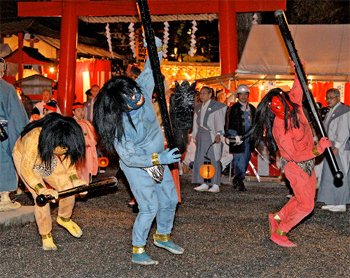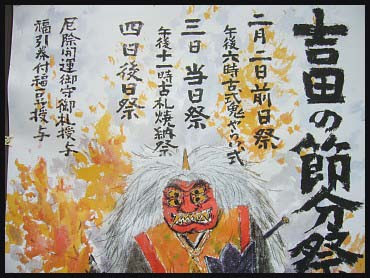https://gokurakuparadies.blogspot.jp/2017/08/taizan-fukun-hell-king.html
Taizan Fukun 泰山府君 / 太山府君 King of Hell
Taizan-O 太山王(泰山王) King Taizan
::::::::::::::::::::::::::::::::::::::::::::::::::::::::::::::::::::::::::::::::::::::::::::::::::::::::::::::::::::::::::::::::::::::::::::::::::::::::::::::::::::::::::::::
. Japanese Legends - 伝説 民話 昔話 – ABC-List .
................................................................................. Fukui 福井県
遠敷郡 Onyū - Onyu district 名田庄村 Natashomura
Osaizangitsune おさいざん狐 a fox named O-Saizan
On a rock above the shrine 加茂神社 Kamo Jinja there lives a 白狐 white fox called O-Saizan. He/she is the protector of Taizan Fukun.
The 狐の火の玉 fire ball of the fox can fly from 天壇 the heavenly abode of Taizan Fukun all the way to this Kamo Shrine.
加茂神社 Kamo Jinja
福井県大飯郡おおい町名田庄納田終127-4

After the Ōnin War 応仁の乱 Onin no Ran in 1467, members of 土御門家 the clan of Tsuchimmikado (from a branch-family of Abe no Seimei 阿倍晴明 (921 - 1005)) fled here. They were strong believers in the power of Kamo Jinja shrine in Kyoto and spread the belief in this shrine in the region.
In the village there are still many thatched-roof houses that have retained their form for centuries.
. Tsuchimikado, Tsuchi no Mikado 土御門天皇 (1196 – 1231) .
- reigned from 1198 to 1210.
- and the famous Onmyōji, Abe no Seimei 阿倍晴明 (921 - 1005)
. Kyoto - The Kamo Shrine complex .
Shimogamo Shrine 下鴨神社 and Kamigamo Shrine 上賀茂神社
. kitsune densetsu 狐 伝説 fox legends .
..............................................................................................................................................
- reference : Nichibun Yokai Database -
::::::::::::::::::::::::::::::::::::::::::::::::::::::::::::::::::::::::::::::::::::::::::::::::::::::::::::::::::::::::::::::::::::::::::::::::::::::::::::::::::::::::::::::
. Pilgrimages to Fudo Temples 不動明王巡礼
Fudo Myo-O Junrei - Fudo Pilgrims - INTRODUCTION .
. Japan - Shrines and Temples - Index .
[ . BACK to DARUMA MUSEUM . TOP . ]
[ . BACK to WORLDKIGO . TOP . ]
- - #taizanfukun -
::::::::::::::::::::::::::::::::::::::::::::::::::::::::::::::::::::::::::::::::::::::::::::::::::::::::::::::::::::::::::::::::::::::::::::::::::::::::::
Taizan Fukun 泰山府君 / 太山府君 King of Hell
Taizan-O 太山王(泰山王) King Taizan
::::::::::::::::::::::::::::::::::::::::::::::::::::::::::::::::::::::::::::::::::::::::::::::::::::::::::::::::::::::::::::::::::::::::::::::::::::::::::::::::::::::::::::::
. Japanese Legends - 伝説 民話 昔話 – ABC-List .
................................................................................. Fukui 福井県
遠敷郡 Onyū - Onyu district 名田庄村 Natashomura
Osaizangitsune おさいざん狐 a fox named O-Saizan
On a rock above the shrine 加茂神社 Kamo Jinja there lives a 白狐 white fox called O-Saizan. He/she is the protector of Taizan Fukun.
The 狐の火の玉 fire ball of the fox can fly from 天壇 the heavenly abode of Taizan Fukun all the way to this Kamo Shrine.
加茂神社 Kamo Jinja
福井県大飯郡おおい町名田庄納田終127-4

After the Ōnin War 応仁の乱 Onin no Ran in 1467, members of 土御門家 the clan of Tsuchimmikado (from a branch-family of Abe no Seimei 阿倍晴明 (921 - 1005)) fled here. They were strong believers in the power of Kamo Jinja shrine in Kyoto and spread the belief in this shrine in the region.
In the village there are still many thatched-roof houses that have retained their form for centuries.
. Tsuchimikado, Tsuchi no Mikado 土御門天皇 (1196 – 1231) .
- reigned from 1198 to 1210.
- and the famous Onmyōji, Abe no Seimei 阿倍晴明 (921 - 1005)
. Kyoto - The Kamo Shrine complex .
Shimogamo Shrine 下鴨神社 and Kamigamo Shrine 上賀茂神社
. kitsune densetsu 狐 伝説 fox legends .
..............................................................................................................................................
- reference : Nichibun Yokai Database -
::::::::::::::::::::::::::::::::::::::::::::::::::::::::::::::::::::::::::::::::::::::::::::::::::::::::::::::::::::::::::::::::::::::::::::::::::::::::::::::::::::::::::::::
. Pilgrimages to Fudo Temples 不動明王巡礼
Fudo Myo-O Junrei - Fudo Pilgrims - INTRODUCTION .
. Japan - Shrines and Temples - Index .
[ . BACK to DARUMA MUSEUM . TOP . ]
[ . BACK to WORLDKIGO . TOP . ]
- - #taizanfukun -
::::::::::::::::::::::::::::::::::::::::::::::::::::::::::::::::::::::::::::::::::::::::::::::::::::::::::::::::::::::::::::::::::::::::::::::::::::::::::














































